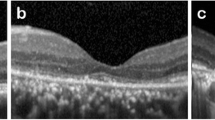Abstract
Purpose
To compare the lesion characteristics of two different types of confocal scanning laser ophthalmoscopy (cSLO) autofluorescence (AF) images in central serous chorioretinopathy (CSC).
Methods
The study included 63 eyes of 61 patients; 63 pairs of fundus autofluorescence (FAF) images were compared before CSC resolution in 63 eyes, FAF images of 31 eyes were also compared after CSC resolution. The lesion characteristics (brightness and composite pattern) were compared between Heidelberg Retina Angiograph 2 (HRA2; Heidelberg Engineering, Germany) and Optomap Tx (Optomap; Optos, Scotland) FAF images. The lesion composite pattern was categorized as diffuse or granular. Diffuse AF was defined as homogenously increased or decreased AF, and granular AF was defined as dot-like, coarse changes in AF. The mean disease duration and subretinal fluid (SRF) height in the spectral domain optical coherence tomography were compared according to the FAF image characteristics.
Results
Lesion brightness before CSC resolution was hypo-AF in 48 eyes (76.2 %), hyper-AF in three (4.8 %), and mixed-AF in 12 (19.0 %) in HRA2 FAF images. In comparison, nine (14.3 %) images were hypo-AF, 44 (69.8 %) were hyper-AF, and 10 (15.9 %) were mixed-AF in Optomap FAF images (P < 0.0001). There was no significant difference in lesion composite pattern between the two FAF image wavelengths. Patients with lesions that were hyper-AF in Optomap FAF and hypo-AF in HRA2 FAF had a shorter disease duration and greater SRF height (1 month, 281 um) than those who were hyper-AF in both Optomap and HRA2 images (26 months, 153 um; P = 0.004, 0.001).
Conclusions
The two types of FAF images of CSC showed different lesion brightness before and after CSC resolution but demonstrated similar lesion composite patterns.



Similar content being viewed by others

References
Eandi CM, Ober M, Iranmanesh R et al (2005) Acute central serous chorioretinopathy and fundus autofluorescence. Retina 25:989–993
Framme C, Walter A, Gabler B et al (2005) Fundus autofluorescence in acute and chronic recurrent central serous chorioretinopathy. Acta Ophthalmol Scand 83:161–167
Dinc UA, Tatlipinar S, Yenerel M et al (2011) Fundus autofluorescence in acute and chronic central serous chorioretinopathy. Clin Exp Optom 94:452–457
Spaide RF, Klancnik JM Jr (2005) Fundus autofluorescence and central serous chorioretinopathy. Ophthalmology 112:825–833
Deli A, Moetteli L, Ambresin A, Mantel I (2013) Comparison of fundus autofluorescence images acquired by the confocal scanning laser ophthalmoscope (488 nm exCitation) and the modified Topcon fundus camera (580 nm excitation). Int Ophthalmol 33:635–643
Spaide R (2008) Autofluorescence from the outer retina and subretinal space: hypothesis and review. Retina 28:5–35
Ayata A, Tatlipinar S, Kar T et al (2009) Near-infrared and short-wavelength autofluorescence imaging in central serous chorioretinopathy. Br J Ophthalmol 93:79–82
von Ruckmann A, Fitzke FW, Fan J et al (2002) Abnormalities of fundus autofluorescence in central serous retinopathy. Am J Ophthalmol 133:780–786
Hanazono G, Tsunoda K, Kazato Y et al (2012) Functional topography of rod and cone photoreceptors in macaque retina determined by retinal densitometry. Invest Ophthalmol Vis Sci 53:2796–2803
Morgan JI, Pugh EN Jr (2013) Scanning laser ophthalmoscope measurement of local fundus reflectance and autofluorescence changes arising from rhodopsin bleaching and regeneration. Invest Ophthalmol Vis Sci 54:2048–5059
Ojima A, Iida T, Sekiryu T et al (2011) Photopigments in central serous chorioretinopathy. Am J Ophthalmol 151:940–952
Theelen T, Berendschot TT, Boon CJ et al (2008) Analysis of visual pigment by fundus autofluorescence. Exp Eye Res 86:296–304
Bui TV, Han Y, Radu RA et al (2006) Characterization of native retinal fluorophores involved in biosynthesis of A2E and lipofuscin-associated retinopathies. J Biol Chem 281:18112–18119
Matsumoto H, Kishi S, Sato T, Mukai R (2011) Fundus autofluorescence of elongated photoreceptor outer segments in central serous chorioretinopathy. Am J Ophthalmol 151:617–623
Campbell FW, Gubisch RW (1966) Optical quality of the human eye. J Physiol 186:558–578
Dreher AW, Bille JF, Weinreb RN (1989) Active optical depth resolution improvement of the laser tomographic scanner Appl. Opt 28:804–808
Maass A, von Leithner PL, Luong V et al (2007) Assessment of rat and mouse RGC apoptosis imaging in vivo with different scanning laser ophthalmoscopes. Curr Eye Res 32:851–861
Ahn SE, Oh J, Oh JH et al (2013) Three-dimensional Configuration of Subretinal Fluid in Central Serous Chorioretinopathy. Invest Ophthalmol Vis Sci 54:5944–5952
Song IS, Shin YU, Lee BR (2012) Time-periodic characteristics in the morphology of idiopathic central serous chorioretinopathy evaluated by volume scan using spectraldomain optical coherence tomography. Am J Ophthalmol 154:366–375
Sekiryu T, Iida T, Maruko I et al (2010) Infrared fundus autofluorescence and central serous chorioretinopathy. Invest Ophthalmol Vis Sci 51:4956–4962
Acknowledgments
Dr. Seong-Woo Kim received a grant from Korea University (K1400629), and Dr. Jaeryung Oh received a grant (A102024) from the Korean Health Technology R&D Project, Ministry for Health, Welfare & Family Affairs, Republic of Korea.
All authors certify that they have no affiliations with or involvement in any organization or entity with any financial interest (such as honoraria; educational grants; participation in speakers’ bureaus; membership, employment, consultancies, stock ownership, or other equity interest; or expert testimony or patent-licensing arrangements) or non-financial interest (such as personal or professional relationships, affiliations, knowledge, or beliefs) in the subject matter or materials discussed in this manuscript.
Author information
Authors and Affiliations
Corresponding author
Rights and permissions
About this article
Cite this article
Nam, K.T., Yun, C.M., Kim, J.T. et al. Central serous chorioretinopathy fundus autofluorescence comparison with two different confocal scanning laser ophthalmoscopes. Graefes Arch Clin Exp Ophthalmol 253, 2121–2127 (2015). https://doi.org/10.1007/s00417-015-2958-6
Received:
Revised:
Accepted:
Published:
Issue Date:
DOI: https://doi.org/10.1007/s00417-015-2958-6



